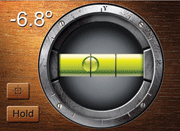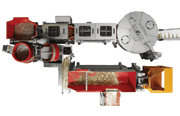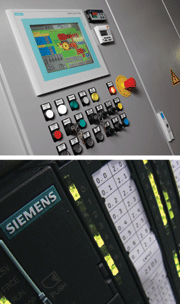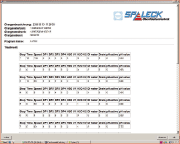E-Archive
Good Vibrations
in Vol. 11 - July Issue - Year 2010
Good Vibrations, Smart Vibrations

Figure 1: IT embedded products give more benefit to customers, here the Apple iPhone Air Level Application

Figure 2: complex fully automatic centrifugal finishing unit with highly developed PLC unit and PC connected relational database

Figure 3: broad PLC functionality brings advantages not only in process stability and quality control

Figure 4: sample PC report of batch programs on a finishing unit for better quality
Smart Phones – Smart Machines?
Information technology today is broadly used. Some people even think that IT has reached the end of its build-out as an infrastructural technology. Scientific literature gives no homogenous picture of the question of how information technology is contributing to competitive advantage. Citations like "IT does not matter" by Nicolas Carr1 or "You can see the computer age everywhere but in the productivity statistics" by Erik Brynjolfsson2 hint at the uncertainty about IT’s impact on sustainable competitive advantage. These opinions define IT as a medium to process and to store data, not as connected business processes or as product embedded IT.
In the case of product embedded IT there is much agreement that smarter products with more IT are definitely creating competitive advantage. Here IT can help to differentiate a product from rival offerings. Furthermore this possibility becomes more important, if your company tries to apply a focused differentiation strategy as a niche provider. The niche strategy as one of the generic strategies was already exhaustively described by Dirk Gather in the last article of this column. Today many classic products are pepped up with additional features made possible by the usage of information technology. Mobile Phones became Smart Phones. Cars are becoming more and more intelligent. Mechanics are using Laptops for maintenance purposes rather than a spanner. Coffee machines can be connected to the in-house Ethernet control system.3 Products became more sophisticated and the phrase of the "internet of things" by RFID tagged products is already old.
But what is the situation in the classical mechanical engineering, especially in the surface finishing world? Do we have Smart Machines? Is there any similar development? At first sight the impact of IT on classical mass finishing concepts is quite low. The good old barrel drum looks very similar to the model of 1920 and the simple timer in its control unit is no eye-catcher at all. Also simple round-tub vibrators have changed little in the last years if you regard their mere core functionality.
But the situation is different if you consider the more complex interlinked finishing installations. Here a couple of machine components interact with each other, ensuring a secure and efficient parts flow, often connected to pre- and post-treatment installations. In most cases the automation degree of the factory environment of these complex finishing machines is on a higher level and the finishing units are integrated in fully automatic production lines. Process stability and quality management are terms of high importance for these manufacturing companies.
A good niche provider recognizes these needs and indeed today in Germany we have very sophisticated mass finishing installations, mainly in the form of a flow-through or centrifugal finishing concept. In contrast to earlier concepts these installations use a complex PLC unit with touch-screen, often in combination with a personal computer. The man-machine interaction is facilitated enormously by high quality touch-screens, which give detailed information about the status of the machine and the parts produced on it. Furthermore the database on the connected PC archives the historical treatments with machine parameters and occurred errors, giving valuable data for quality, for continuous improvement processes and for production scheduling. The production officer knows exactly which part batch was produced at what time and with which parameters and has a detailed output control.
Treatment programs for different parts increase the productivity as the setup costs to change parts are reduced. Information is directly at hand, for example the consumption of machine compounds and other chemical additives can be recorded in the PC. From there every function in the office administration has access via Ethernet network in real time to the information stored in the database at the machine and the purchaser can order in time the compounds which are running low.
Additionally more detailed quality relevant machine functions can be digitalized. For example the water-level control. Dependent on water quality the outflow in the water tubes can be reduced by sediments over time. With the help of specific sensors the CPU of the finishing installation can control and finally adjust this water outflow. That ensures the process stability within the working tub of the machine. If errors occur the operator or departmental leader can be informed by Ethernet connectors or by a GSM modem via SMS. Generally the electronic functionality leads to more ease-of-use and more machine and operator security.
For a niche provider the entrepreneurial thinking does not stop at improvements for their own product. As the transfer of parts to and from finishing installations is often a question, the customer expects a complete solution including the correct handover of his parts. Sometimes this hand-off demands a correct position of a flat part. In such cases peripheral units or sensors together with a gripper to change the position of a part are connected with the central processing unit of the finishing machine. Such a sensor could for example be a camera. That device optically controls the right position of a part, which should be transferred to an after-treatment machine. It gives the result information back to the control unit, which can pilot the gripper to move the part to another position. This is only one example of multiple possible peripheral units which can be combined to the central brain of a finishing installation to enhance its productivity.
So it seems to be true that we have actually also a trend for smarter machines. The smartest ones can differentiate themselves successfully from rival products. Perhaps not all producers have the need for smart machines and for highest quality production as they aim to supply low cost products with medium quality. But the number of companies with highest process and quality aims is rising, and therefore the need for smarter surface finishing machine solutions.
1 comp. Carr (2003), Harward Business Review 5/2003
2 comp. Brynjolfsson, Erik (1993). "The productivity paradox of information technology"
3 comp. www.haus-automatisierung-der-gegenwart.de
Good Vibrations
by Mathieu Geuting
Spaleck Oberflächentechnik GmbH & Co. KG, Germany
Tel. +49.2871.9500.14
Fax +49.2871.9500.95
E-mail: m.geuting@spaleck.biz



























